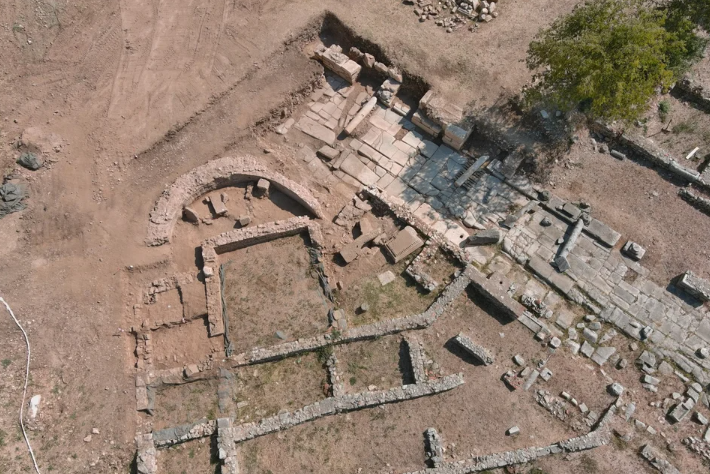Philippi: A laurel-crowned marble head with a rich hair was discovered
- Written by E.Tsiliopoulos
A marble-paved street, a square, a male head and a richly decorated building were discovered by a team of archaeologists in Philippi.
Last September, the excavation research carried out by the Aristotle University team in Philippi under the direction of the professor of Byzantine Archeology Natalia Poulos and with direct collaborators, the assistant professor of Byzantine Archeology Anastasios Tantsis and professor emeritus of Byzantine Archeology Aristotle Mentzos, was completed.
The findings of this year's research in Philippi
This year the excavation continued east of the southern main street (decumanus) at the point where it meets the northern axis of the city (the so-called "Egnatia"). The continuation of the marble-paved road was revealed, on its surface where a coin (bronze follis) of the emperor Leo VI (886-912) was found, an element that helps to determine the duration of use of the road.
At the point of convergence of the two streets, a widening (square) appears to be taking shape, dominated by a richly decorated building. The evidence from last year's excavation led us to hypothesize that it was a fountain. The findings of this year's research confirm this view and help us better understand its shape and function.
Excavations in 2022 brought to light part of the rich decoration of the fountain, the most impressive of which is the statue depicting Heracles barren with a youthful body.
The recent excavation (2023) revealed the head of another statue: it belongs to a bearded male figure with a rich crown surmounted by a wreath of laurel leaves. This beautiful head seems to belong to a statue of the god Apollo. Like the statue of Herakles, it dates back to the 2nd or early 3rd century. A.D. and probably adorned the fountain, which took its final form during the 8th to 9th centuries.

We know from the sources as well as from the archaeological data that in Constantinople statues from the classical and Roman periods adorned buildings and public spaces until the late Byzantine period.
This find reinforces the hypothesis formulated in 2022 about the way public spaces were decorated in the important cities of the Byzantine Empire, including Philippi.
The excavation in Philippi will continue next year.
Related items
-
 The three Greek honeys that are PDO
The three Greek honeys that are PDO
-
 Video of the execution of a Greek mobster in Canada, inside a cafe - He was known as "Bobby the Greek"
Video of the execution of a Greek mobster in Canada, inside a cafe - He was known as "Bobby the Greek"
-
 Marina Satti nominated for the UK Music Video Awards 2025
Marina Satti nominated for the UK Music Video Awards 2025
-
 A Mycenaean clay amphora from the Late Bronze Age is being presented for the first time at the Archaeological Museum of Thessaloniki
A Mycenaean clay amphora from the Late Bronze Age is being presented for the first time at the Archaeological Museum of Thessaloniki
-
 Ellinikon: 17,000 interested buyers from 110 countries to buy an apartment - The profile and motivations, the new neighborhoods
Ellinikon: 17,000 interested buyers from 110 countries to buy an apartment - The profile and motivations, the new neighborhoods
Latest from E.Tsiliopoulos
- The three Greek honeys that are PDO
- Video of the execution of a Greek mobster in Canada, inside a cafe - He was known as "Bobby the Greek"
- Marina Satti nominated for the UK Music Video Awards 2025
- A Mycenaean clay amphora from the Late Bronze Age is being presented for the first time at the Archaeological Museum of Thessaloniki
- Ellinikon: 17,000 interested buyers from 110 countries to buy an apartment - The profile and motivations, the new neighborhoods

